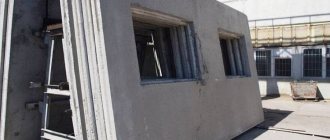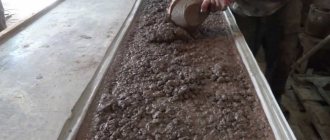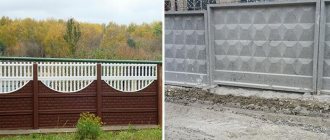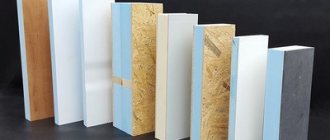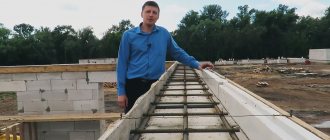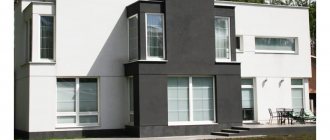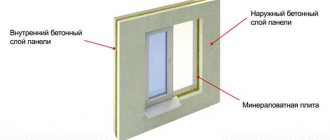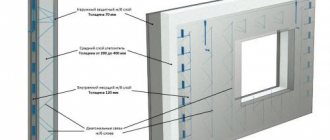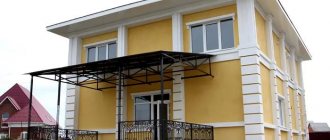A modern concrete fence has high performance qualities and can satisfy the most demanding needs. Such fencing has a wide range of applications; they amaze with their diversity not only in design, but also in appearance. It is customary to distinguish the following types of concrete fences:
- monolithic self-standing fencing;
- decorative one- and two-sided concrete fences;
- typesetting with the possibility of final decorative finishing;
- combined.
A self-standing fence is made from monolithic sections; it is distinguished by its laconic design, reliability and durability. Individual blocks are heavy, their dimensions depend on the installation location. Installation requires a pre-prepared foundation; fencing is usually used for production areas, warehouses, parking lots, and country houses.
A decorative fence can be one- or two-sided; it has a wide variety of shapes and designs; it is usually made up of separate small sections that can be mounted without a special foundation. The textured surface of the concrete section can imitate brick, natural stone or wood. Fences of this type are used for private homes, public buildings, and schools.
After installation, stacked sections reinforced with steel rods can be painted in any color or any type of tile can be used for finishing, which makes the fence more attractive.
Composite fencing typically combines concrete and wrought iron elements to create a custom design. Most often, such fences are used for country houses, giving the site a solid appearance and harmonizing with the landscape design.
self-sufficient
decorative
combined
Types of concrete fences also include the following groups:
- solid sections, can be of greater height, are usually used for areas where maximum protection from visibility from the street is required;
- decorative openwork and partially openwork designs, excellent for country houses, have decorative permeable inserts that provide ventilation of the area and partial visibility.
Advantages of the design
A reliable and attractive fence made of concrete sections has many advantages, including:
- Weather resistance . Structures in the form of concrete sections are resistant to frost, precipitation, sudden temperature changes, and high humidity. The appearance and condition of the fence are not affected by factors such as frequent rains, snow loads, salty sea air or fogs. Such fences can be safely used in regions with a high degree of air pollution, in climatically unfavorable areas, for example, in the north.
- Durability . The estimated service life is 40-50 years, but with proper care the fence will last much longer without requiring repair or replacement. The use of vibration casting during the manufacture of sections makes it possible to remove air from the mixture as much as possible. This ensures increased density of the structure, increasing its frost resistance and stability in high humidity. Such fencing is guaranteed to withstand up to 350 freeze-thaw cycles, but only if all the conditions of the section manufacturing technology are met.
- High strength . During the manufacture of sections, reinforcement is used using smooth or corrugated steel rods. This makes it possible to increase resistance to mechanical loads and increase the durability of the structure.
- Mobility . The structure is collapsible; if necessary, it can be removed and moved to a new location, for example, when expanding the site.
- Enhanced aesthetics . The peculiarity of manufacturing sections allows you to produce sections of any size and shape, simulating the surface of stone, brick, wood. Adding pigments to the solution allows you to give the fence an individual, very attractive appearance.
- Quick installation . This type of fencing is installed very quickly; when using small sections, the use of heavy construction equipment is not required.
- Geometry of sizes . The use of special shapes in the production of sections ensures the stability of the geometric dimensions of each element. This makes it possible to quickly and efficiently perform installation using standard supports with grooves.
Characteristics
Decorative fences made of concrete are often called Euro fences. Their design is both a fence and a decoration for country houses. The increased demand for them is due to a number of factors, including:
- structural strength, which allows you to avoid mechanical damage with virtually no maintenance work;
- the surface of the product is not subject to destruction due to the influence of natural factors in the form of precipitation, seasonal temperature changes, direct exposure to sunlight;
- high durability of products that are designed for at least 30 years;
- compactness, simplicity and ease of installation, allowing to minimize the amount of work during installation and labor costs;
- aesthetically original appearance. The decorative decoration of Euro fences is replete with a variety of shapes and designs. The reinforced base and concrete pouring turned out to be a flexible tool, thanks to which you can implement many design solutions and original options for building a beautiful fence for any home, even the most sophisticated from an architectural point of view.
Creating fence components
The design of sectional concrete includes:
- sections of different shapes and sizes;
- support posts (it is recommended to use special supports with grooves to facilitate installation);
- foundation (depending on the characteristics of the fence, it can be strip or point for supports);
- gate and wicket.
During installation, the foundation is laid first and the supports are installed. Sections can be purchased ready-made or made yourself. But this will require special equipment and materials, and some work skills.
Application
Decorative fences are becoming more and more popular and in demand every year. Moreover, the demand for them exists not only from private landowners, who thus want to emphasize the sophistication of their taste and equip their property with an effective and at the same time aesthetic fencing. The prefabricated fence structure is universal in its design and purpose, allowing it to be used in gardening areas, for fencing recreational areas, private and public facilities: kindergartens, schools, hospitals, etc.
Stages of installation of a concrete sectional fence
Installation of a concrete sectional fence usually requires preliminary preparation of the base in the form of a shallowly buried strip. To do this, it is necessary to mark the perimeter of the site, dig a trench with a sand cushion and formwork. Next, the supporting elements are installed and the concrete mixture is poured. Since the dimensions of a monolithic reinforced concrete fence slab are quite large, installation may require a crane or other equipment that will help install each section strictly in place.
marking
sand cushion
formwork
Installation of a decorative fence with small sections can be carried out without the use of construction equipment. But it is recommended to involve 3-4 people in the work to install supports and sections. If large sections will be used during installation, a crane may be required for the work.
The installation process of sectional fencing includes the following steps:
- the territory is marked around the perimeter (the distance between the supports should be about 2 meters);
- foundation work is being carried out;
- support pillars are mounted, for which it is recommended to use a building level to check verticality;
- Concrete slabs are fastened into place, after which final decorative work is carried out if necessary
- To install gates and wickets, separate posts are mounted to which metal inserts for the doors are welded.
Materials for poles and their combinations with a fence
Traditionally, metal, wood, brick and concrete are used for supports:
Metal
Example of the height of metal fence supports
Metal poles are made in the form of pipes or profiles, hollow inside, ending with plugs. It happens that they are equipped with ears, hooks and other details. Basically, they are used to support sections made of corrugated sheets, forged lattice or mesh.
Article on the topic: How to calculate the power of a homemade sauna stove
An interesting type of iron “support” is screw piles. At the base they have wide blades, which allows them to be held in the depression of the earth. The advantage of piles is their light weight and ease of installation.
Wooden
Wooden poles, both round and square, are installed as temporary structures, since they last only 10-15 years, with proper care. They are used in the construction of country houses and front gardens.
Such supports are used to support light-weight fences, such as wooden picket fences and chain-link mesh. To protect it from destruction, the lower part of the log is treated with a primer and resin; metal “shoes” for such supports are commercially available. Their convenience is mobility, which is convenient for temporary buildings.
Concrete
Diagram of brick fence supports with height indication
It is advisable to install concrete pillars to support heavy fences made of the same material as the supports. Their weight is large, and together with the fence it will be considerable. Therefore, without special equipment for installing a fence, such a colossus cannot be moved if necessary. Although decorative fences weigh a little less, and installing posts for them is much easier.
Brick
Brick pillars are considered expensive acquisitions. They are most often built for mansions and country estates. They are combined with brickwork, wood or polycarbonate sections.
Their height, as a rule, is no more than 3-4 meters, type of masonry: one and a half bricks or two bricks. They must be protected from above by a cap (metal or concrete).
Tools for work
To install a concrete fence, you will need the following materials and equipment:
- Portland cement M400-500;
- sifted river sand;
- crushed stone;
- pure water;
- pigment (if sections of a certain shade are required);
- silicone or plastic molds for pouring;
- machine oil for lubricating molds;
- vibrating table;
- electric concrete mixer;
- shovel;
- pegs for marking;
- building level, plumb line;
- ready-made supports with grooves.
If one section is heavy, lifting equipment will be required, but usually a sectional fence can be installed by 3-4 people.
Weight of fence slabs
home ⇒ construction mat ⇒ reinforced concrete ⇒ slabs
When constructing fencing structures around objects for various purposes, concrete fence slabs with a length of 3.98 (m), a thickness of 0.16 (m), a height of 2.2 (m), and a weight of 1600 (kg) are often used.
Weight of a reinforced concrete fence slab, dimensions are indicated in the “length/thickness/height” format:
- P-6VA 3980x160x2200 (mm) – 1600 (kg).
Weight of reinforced concrete posts for fencing:
- C - 3B 3000x140x140 (mm) - 150 (kg);
- SS (with grooves) 3800x250x250 (mm) – 440 (kg).
Weight of reinforced concrete supports for fencing:
- AF-1 800x800x400 (mm) – 250 (kg);
- FB-1 800x800x500 (mm) – 400 (kg).
Important: the production of concrete fence elements is regulated by GOST 12767-94, GOST 13579-78, TU 67-07-232-89.
Total weight of fence slabs Drawing Drawing and parameters of a standard model Slab (kg) Weight of the P-6VA slab in (kg) Stand (kg) Weight of the AF-1 slab stand in (kg) Post (kg) Weight of the S-3V fence post in (kg )
| Fence | 160 (kg) | 250 (kg) | 150 (kg) |
Table of mass of reinforced concrete fence elements Brand Brand of product m (kg) Weight of product in (kg) v (m3) Volume of product in (m3)
| Stove P-6VA | 1,60 | 0,64 |
| Stand AF-1 | 0,250 | 0,10 |
| Stand FB-1 | 0,400 | 0,16 |
| Column C - 3B | 0,150 | 0,06 |
| SS post with grooves | 0,44 | 0,18 |
Calculation of the number of sections
When planning the installation of a concrete fence, it is necessary to pay great attention to calculating the size of one section and the total number of elements. The standard dimensions of one section of the fence are 2 meters wide and 1.5-2 meters high. When calculating the number of sections. It must be taken into account that the total length of the section is 2.06 meters (2 meters is the working width), to this value it is necessary to add the cross-section of the support column and the presence of technological gaps.
When making calculations, the perimeter of the fence is first calculated, and the width of the gate and supports for the doors is subtracted from the resulting value. Next, the number of supports is calculated, and two pillars are dug in at once in the corner parts of the fence, that is, their cross-section is doubled. The remaining value is divided by the total width of one section, allowing you to obtain the number of slabs for installation.
Special orders
Directly after production, concrete fences are gray in color. But if you want to add artistic decoration in color, then our craftsmen will paint the panels with high-quality and durable paints. Below are some of our works with additional artwork.
Eurofence No. 7 art. zb-10-10-9 + coloring
panels x-51-52
Eurofence No. 25 art. zb-57-58-86 + coloring
panels 150-150's
Solutions for concrete fence
One of the most important steps in the manufacture of concrete sections is the correct choice of solution and its proportions. It is on this that parameters such as strength, durability of the structure, and resistance to loads will depend.
The basis of the solution is cement; experts recommend taking M400 or M500, which have the necessary qualities. Screened river sand without clay inclusions is used as filler. Before mixing, it is recommended to sift the sand mixture again.
When choosing the proportion of the solution, you need to focus on the brand of concrete; among the recommended proportions are the following:
- Portland cement M400 B30 is used for mixing. The proportion of the solution is 1:1.2:2.7 (cement, sand mixture and granite crushed stone, respectively). The volumetric composition for 10 liters of cement will be 11 liters of sand and 22 liters of crushed stone. The yield of concrete per 10 liters of cement will be 31 liters of finished solution.
- When using Portland cement M450, the following proportion is observed: 1:1.1:2.5 (cement, sand, crushed stone, respectively). The volumetric composition is 10: 22 (sand mixture to crushed stone), the amount of the finished solution will be 29 liters per 10 liters of dry cement.
An electric concrete mixer is used to mix the solution (a manual one may not produce the required quality). Water is added gradually, the finished consistency should resemble thick sour cream.
If you want to obtain colored sections, then special pigments are added to the solution during mixing. Their quantity is indicated by the manufacturer, the substances themselves are distinguished by rich shades, they do not fade in the bright sun, and do not wash out. Such a fence does not require additional painting after installation.
Video: proportions and composition of concrete
Dimensions of concrete products (full tables) - Dimensions Info
home ⇒ construction mat
Reinforced concrete products are conventionally divided into: slabs, fences, pillars, curbs and rings.
The reinforced concrete industry is strictly regulated by GOST. This is due to the typification of the construction industry.
Each reinforced concrete product has a corresponding GOST, which, in addition to the requirements for quality of execution, also specifies dimensions.
The sizes of reinforced concrete products of the main types are presented below.
A separate section is devoted to each type with detailed size tables and regulatory documentation.
Dimensions of the main types of reinforced concrete products Drawing Drawing and parameters of a standard model L (mm) Total length of the product in (mm) B (mm) Total width of the product in (mm) H (mm) Total thickness of the product in (mm)
| Floors(go) | from 3580 (mm) to 6280 (mm) | from 1190 (mm) to 1790 (mm) | Series 1.141.1-39 |
| Curbs(go) | from 1000 (mm) to 6000 (mm) | from 150 (mm) to 320 (mm) | from 200 (mm) to 600 (mm) |
| Pillars(go) | from 9500 (mm) to 13600 (mm) | from 220 (mm) to 290 (mm) | from 165 (mm) to 412 (mm) |
| Reinforced concrete rings(go) | d1 from 700 (mm) to 2500 (mm) | d2 from 840 (mm) to 2800 (mm) | — |
| Concrete concrete lintels (go) | from 1030 (mm) to 5950 (mm) | from 120 (mm) to 250 (mm) | from 65 (mm) to 585 (mm) |
| Runs(go) | from 2750 (mm) to 6580 (mm) | 300 (mm)400 (mm)440 (mm) 500 (mm) | 120 (mm)200 (mm) 380 (mm) |
| Precast concrete beams(go) | from 1030 (mm) to 5950 (mm) | from 120 (mm) to 250 (mm) | from 65 (mm) to 585 (mm) |
| March(go) | from 2720 (mm) to 3030 (mm) | from 1400 (mm) to 1500 (mm) | from 1050 (mm) to 1200 (mm) |
| Steps(go) | from 900 (mm) to 2400 (mm) | from 260 (mm) to 470 (mm) | from 40 (mm) to 168 (mm) |
| Reinforced concrete sleepers(go) | 2700 (mm) | 300 (mm) | 145 (mm)206 (mm) 230 (mm) |
| Eurofence(go) | 2000 (mm) | 500 (mm) | 40 (mm) |
| FBS(go) | from 880 (mm) to 2380 (mm) | from 300 (mm) to 600 (mm) | from 280 (mm) to 580 (mm) |
The process of pouring concrete mixture into a finished mold
After mixing, the concrete mixture is carefully poured into molds. For the manufacture of sections, two methods are used - instant formwork and exposure. Both are based on vibration casting, that is, it is necessary to use a vibrating table and special molds.
The mixture is poured into fiberglass molds and placed on a vibrating table to compact the solution. In the first case, the form is removed immediately after the concrete compaction process is completed. In the second case, the solution remains in the formwork used until it gains strength.
To make the fencing sections more reliable and resistant to mechanical and other loads, it is recommended to use smooth or corrugated metal rods. Reinforcement is performed at the pouring stage; such a simple technology allows you to correctly distribute the loads on the fence sections and increase their resistance to external loads.
When choosing a production method, the operating features of the fence are taken into account. Products made using the exposure method are distinguished by greater strength, complete absence of defects and improved aesthetics. Products made using the instant formwork method are used for industrial areas, warehouses, and car parks. They do not have such high aesthetics; minor defects are possible on their surface. But the performance characteristics remain just as high.
Varieties and design features
The designs of modern fences are represented by a number of modifications, which not only have external differences, but also affect the complexity of manufacturing the products and their cost. The following types of fences are distinguished:
- open-type products, which are characterized by a design with windows of various sizes, providing varying degrees of transparency;
- closed type panels, in which the decorative panel has a solid surface, without any transparency;
- with double-sided decorative design, which is characterized by the presence of an aesthetically designed structure, both on the outside and on the inside;
- one-sided decorative fences, structurally made in such a way that the pattern and relief are visible only from one side, usually the outer side.
